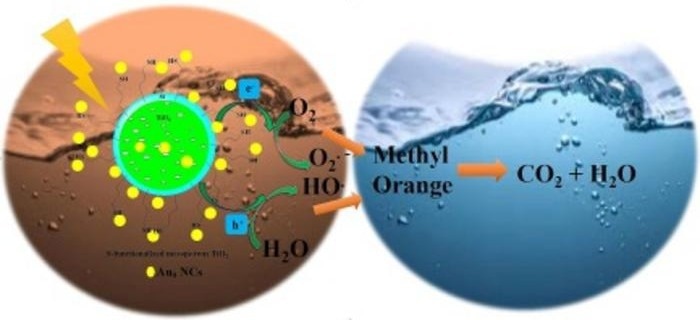Industry and scientists are searching for biocompatible and more sustainable alternatives to preserve the environment, as water contamination from dyes used in food, cosmetics, textiles, and other production processes has become a major ecological problem.
 The novel process involves creating metallic ‘clusters’ of just nine gold (Au) atoms chemically ‘anchored’ to titanium dioxide which in turn drives the reaction by converting the energy of absorbed UV light. Image Credit: Flinders University
The novel process involves creating metallic ‘clusters’ of just nine gold (Au) atoms chemically ‘anchored’ to titanium dioxide which in turn drives the reaction by converting the energy of absorbed UV light. Image Credit: Flinders University
Using a chemical photocatalysis process powered by UV light, a recent study conducted by Flinders University has found a unique approach to degrade and potentially eliminate harmful organic compounds, including azo dyes, from wastewater.
The procedure, according to Professor Gunther Andersson of the Flinders Institute for NanoScale Science and Technology, entails forming metallic “clusters” of just nine gold (Au) atoms that are chemically “anchored” to titanium dioxide. This converts the energy of absorbed UV light to drive the reaction.
A recent scientific article in Solar RRR states that the cocatalysts made of gold nanoclusters improve the titanium dioxide’s photocatalytic activity and cut down on the reaction's completion time by a factor of six.
These types of heterogeneous semiconductor-mediated photocatalysis systems provide a significant advantage over other advanced chemical processes. It can facilitate the mineralization of a large range of organic pollutants, like azo dyes, into water and carbon dioxide molecules with a high degradation efficiency. A variety of physical, chemical and biological processes are currently used to remove carcinogenic and recalcitrant organic compounds from water.
Gunther Andersson, Professor, College of Science and Engineering, Flinders University
Numerous chemical companies, such as those that produce textiles, cosmetics, and dyes, discharge hazardous and non-biodegradable dyes into the environment. Azole dyes make up over half of the dyes used in the textile and dye industry. Methyl orange is a common azo dye that dissolves in water.
With this in mind, Flinders University nanotech researchers have shown that this gold cluster cocatalyst and modified semiconductors could be used to create innovative photocatalysis systems for methyl orange degradation.
The study, just published in Applied Surface Science, investigated photocatalysis in a vortex fluidic device built at Flinders University's nanotechnology laboratory by Professor Colin Raston.
Traditional wastewater treatment techniques, according to co-author Dr. Anahita Motamedisade of Flinders Ph.D., frequently fail to eliminate harmful chemicals from wastewater.
The reason for this is that some chemicals, especially those with aromatic rings, are resistant to chemical, photochemical and biological degradation.
Dr. Anahita Motamedisade, Study Co-Author and Research Fellow, Grifffith University
“In addition, they generate dangerous by-products by oxidizing, hydrolysing, or undergoing other chemical reactions of synthetic dyes containing wastewater, which are detectable wherever they are disposed of. We hope to build onto these more sustainable and thorough photocatalytic degradation processes to help completely remove the toxins and tackle this global problem,” Dr Motamedisade stated.
Dr. Motamedisade’s Ph.D. study, which included improved techniques for treating winery wastewater and was partially supported by Wine Australia, served as inspiration for the study.
The study, “Enhanced Photocatalytic Degradation of Methyl Orange Using Nitrogen-Functionalized MesoporousTiO2 Decorated with Au9 Nanoclusters” (2024) by Anahita Motamedisade, Amir Heydari, Yanting Yin, Abdulrahman S Alotabi and Gunther G Andersson, has been published in Solar RRL (Wiley).
“Au9 clusters deposited as co-catalysts on S-modified mesoporous TiO2 for photocatalytic degradation of methyl orange” (2024) by A Motamedisade, A Heydari, DJ Osborn, AS Alotabi and GG Andersson in Applied Surface Science.
Australian Government and Wine Australia as well as Microscopy Australia (formerly known as AMMRF), the Australian National Fabrication Facility (ANFF) and Flinders Microscopy and Microanalysis and Microscopy Australia at Adelaide Microscopy published the study.
Journal References:
Motamedisade, A., et. al. (2024) Enhanced Photocatalytic Degradation of Methyl Orange Using Nitrogen-Functionalized MesoporousTiO2 Decorated with Au9 Nanoclusters. Solar RRR. doi:10.1002/solr.202300943
Motamedisade, A., et. al. (2024) Au9 clusters deposited as co-catalysts on S-modified mesoporous TiO2 for photocatalytic degradation of methyl orange. Applied Surface Science. doi:10.1016/j.apsusc.2024.159475